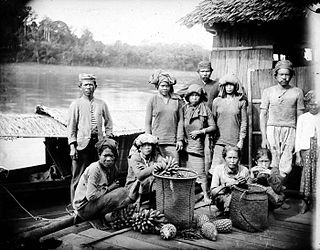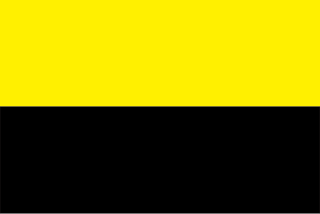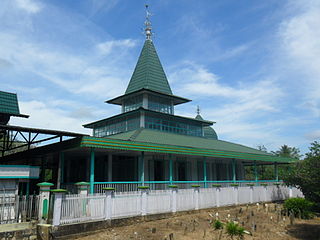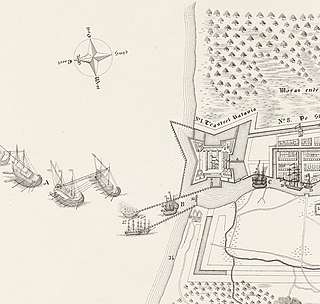Related Research Articles

Majapahit, also known as Wilwatikta, was a Javanese Hindu-Buddhist thalassocratic empire in Southeast Asia that was based on the island of Java. It existed from 1293 to circa 1527 and reached its peak of glory during the era of Hayam Wuruk, whose reign from 1350 to 1389 was marked by conquests that extended throughout Southeast Asia. His achievement is also credited to his prime minister, Gajah Mada. According to the Nagarakretagama written in 1365, Majapahit was an empire of 98 tributaries, stretching from Sumatra to New Guinea; consisting of present-day Indonesia, Singapore, Malaysia, Brunei, southern Thailand, Timor Leste, southwestern Philippines although the scope of Majapahit sphere of influence is still the subject of debate among historians. The nature of Majapahit relations and influences upon its overseas vassals, and also its status as an empire are still provoking discussions.

The Dayak or Dyak or Dayuh are one of the native groups of Borneo. It is a loose term for over 200 riverine and hill-dwelling ethnic groups, located principally in the central and southern interior of Borneo, each with its own dialect, customs, laws, territory, and culture, although common distinguishing traits are readily identifiable. Dayak languages are categorised as part of the Austronesian languages. The Dayak were animist in belief; however, since the 19th century there has been mass conversion to Christianity as well as Islam due to the spreading of Abrahamic religions.

South Kalimantan is a province of Indonesia. It is the smallest province in Kalimantan, the Indonesian territory of Borneo. The provincial capital was Banjarmasin until 15 February 2022 when it was legally moved to Banjarbaru. The population of South Kalimantan was recorded at just over 3.625 million people at the 2010 Census, and at 4.07 million at the 2020 Census. The official estimate as at mid 2021 was 4,112,576. One of the five Indonesian provinces in Kalimantan, it is bordered by the Makassar Strait in the east, Central Kalimantan in the west and north, the Java Sea in the south, and East Kalimantan in the north. The province also includes the island of Laut, located off the eastern coast of Kalimantan. The province is divided into 11 regencies and 2 cities. South Kalimantan is the traditional homeland of the Banjar people, although some parts of East Kalimantan and Central Kalimantan are also included in this criteria. Nevertheless, South Kalimantan, especially the former capital city Banjarmasin has always been the cultural capital of Banjarese culture. Many Banjarese have migrated to other parts of Indonesia, as well as neighbouring countries such as Singapore and Malaysia. In addition, other ethnic groups also inhabit the province, such as several groups of the Dayaks, who mostly live in the interior part of the province, as well as the Javanese, who mostly migrated from Java due to the Transmigration program which dated from the Dutch colonial era.

Banjarmasin is a city in South Kalimantan, Indonesia. It was the capital of the province until 15 February 2022. The city is located on a delta island near the junction of the Barito and Martapura rivers. Historically the centre of the Banjarese culture, and the capital of the Sultanate of Banjar, it is the biggest city in South Kalimantan and one of main cities of Kalimantan. The city covers an area of 98.46 km2 (38.02 sq mi) and had a population of 625,481 at the 2010 Census and 657,663 at the 2020 Census; the official estimate as at mid 2021 was 662,320. Greater Banjarmasin, also known as Banjarbakula, is an urban agglomeration of around two million people covering an area of 8,136 km2 (3,141 sq mi), which includes Banjarbaru city and parts of Banjar Regency, Barito Kuala Regency, and Tanah Laut Regency, and accounts for almost half of the province's population. It is the third most populous city on the island of Borneo.

The Hikayat Banjar is the chronicle of Banjarmasin, Indonesia. This text, also called the History of Lambung Mangkurat, contains the history of the kings of Banjar and of Kotawaringin in southeast and south Borneo respectively.
Negara Daha was a Hindu kingdom successor of Negara Dipa that appears in the Hikayat Banjar. It was located in what is now the Regency of Hulu Sungai Selatan, Province of South Kalimantan, Republic of Indonesia.

Banjarbaru is the capital city of South Kalimantan, one of the provinces in Indonesia. It is located 35 km (22 mi) southeast of Banjarmasin, the largest city of the province. The city had a population of 199,627 as of the 2010 Census, and 253,442 at the 2020 Census, and the official population estimate is 258,750. The town of Martapura lies immediately to the north of Banjarbaru, and in effect constitutes an extension of the city. The second largest city in the province after Banjarmasin, it is also part of Banjarbakula metropolitan area.

The Banjar or Banjarese are an indigenous ethnic group native to the Banjar regions in the southeastern Kalimantan hemisphere of Indonesia. Nowadays, Banjarese diaspora can be found in neighbouring Banjar regions as well; including Kotabaru Regency, the southeastern regions of Central Kalimantan, southernmost regions of East Kalimantan, and some provinces of Indonesia in general. The Banjarese diaspora community also can be found in neighbouring countries of Indonesia, such as Brunei, Malaysia, and Singapore.

Ma'anyan, Dayak Maanyan or Eastern Barito Dayak people are a sub-ethnic group of the Dayak people indigenous to Borneo. They are also considered as part of the east Barito Dusun group with the name Dusun Ma'anyan. According to J. Mallinckrodt (1927), the Dusun people group is part of the Ot Danum people cluster, although later that theory was disproved by A. B. Hudson (1967), who argues that the Ma'anyan people are a branch of the Barito family. The Ma'anyan people who are often referred to as Dayak people are also referred to as Dayak Ma'anyan. The Dayak Ma'anyan people inhabit the east side of Central Kalimantan, especially in the East Barito Regency and parts of South Barito Regency which are grouped as Ma'anyan I. The Dayak Ma'anyan people also inhabit the northern parts of South Kalimantan, especially in Tabalong Regency which refers to the Dayak Warukin people. The Dayak Balangan people or Dusun Balangan people which are found in the Balangan Regency and the Dayak Samihim people that are found in the Kotabaru Regency are grouped together with the Dayak Ma'anyan people group. The Dayak Ma'anyan people in South Kalimantan are grouped as Ma'anyan II.

The Ngaju people are an indigenous ethnic group of Borneo from the Dayak group. In a census from 2000, when they were first listed as a separate ethnic group, they made up 18.02% of the population of Central Kalimantan province. In an earlier census from 1930, the Ngaju people were included in the Dayak people count. They speak the Ngaju language.

Bakumpai or Baraki are indigenous people of Borneo and are considered as a sub-ethnic group of the Dayak Ngaju people group with Islamic background. The Bakumpai people first occupy along the Barito riverbanks in South Kalimantan and Central Kalimantan, from Marabahan to Puruk Cahu, Murung Raya Regency. The Bakumpai people first appeared as a newly recognized people group in census 2000 and were made up of 7.51% of Central Kalimantan population, which before this the Bakumpai people were considered as part of the Dayak people in a 1930 census.

Sultanate of Banjar or Sultanate of Banjarmasin was a sultanate located in what is today the South Kalimantan Province of Indonesia. For most of its history, its capital was at Banjarmasin.
The Negara River is a river of Borneo, Indonesia. It flows in the southeast region of the island, within the Negara District, province of South Kalimantan. It is the second longest river in the province after the Barito River, which the Negara River flows into.

Heritage Mosque of Banua Lawas is an old mosque in Banua Lawas, Tabalong Regency, South Kalimantan. It is one of the oldest mosques in Indonesia. The mosque is also known as Masjid Pasar Arba as there are more pilgrims visiting on Wednesday as it coincides with market day at Banua Lawas. As the oldest mosque in Tabalong regency, in addition to being a place of worship, it is also a milestone and the historical evidence of acceptance of Islam among the Ma'anyan Dayak people in the area.

The Tabalong River is a river traversing Tabalong Regency, in the province of South Kalimantan, Indonesia. The river flows into the Negara River. It is a confluence of two tributaries: the Left Tabalong and Right Tabalong rivers.

Malangbang or melambang is a type of medieval sailing ship from Indonesia. It is mentioned mainly in the History of Banjar. The name "malangbang" is considered to originate from the Old Javanese language, malabong (malaboṅ) which refers to a particular type of boat. Malangbang is one of Majapahit's main naval vessel types after jong and kelulus. Not much is known about this type of ship, apart from the fact that it also used oar beside the sails to propel it, broad and flat-bottomed, and was a "medium-sized" ship, between the size of jong and kelulus, larger and faster than pilang (pelang).

Jukung tambangan is a traditional boat made by the Banjar people of South Kalimantan. They are mainly used for riverine transportation. It is already present at least since mid-18th century. They were not seen anymore in Banjarmasin ca. 1950s and around the 1970s on the Nagara River, Hulu Sungai Selatan Regency.

The Mempawah Kingdom, also known as the Mempawah Sultanate, was an Islamic Dayak kingdom located in a territory now known as the Mempawah Regency, West Kalimantan, Indonesia. The name Mempawah is taken from the term "Mempauh", which is the name of a tree that grows in the upper reaches of the river, also known as the Mempawah River. In its development, Mempawah became known as the name of one of the kingdoms and sultanates that developed in West Borneo. The history of Mempawah is divided into two periods, namely the Dayak kingdom based on Hindu teachings and the period of Islamic influence.
References
- ↑ Yusuf, Yumsari (1987). Unsur sejarah dalam naskah Melayu koleksi Museum Nasional. Museum Nasional. p. 25.
- ↑ . Suriansyah Ideham, eds., 2007. Urang Banjar dan kebudayaannya. Banjarmasin: Badan Penelitian dan Pengembangan Daerah Provinsi Kalimantan Selatan dan Pustaka Banua
- ↑ Mahin, Marko (2004-02-27). "Urang Banjar: Identitas dan Etnisitas di Kalimantan Selatan". Jurnal Kebudayaan Kandil. 6 (II). Retrieved 2022-10-28.
- 1 2 "Nansarunai Ditaklukkan dengan Tiga Misi Militer Majapahit". jejakrekam.com (in Indonesian). 2018-02-24. Retrieved 2022-02-20.
- ↑ Munoz, P. M.; Tim Media Abadi (2009). Kerajaan-kerajaan awal kepulauan Indonesia dan Semenanjung Malaysia: perkembangan sejarah dan budaya Asia Tenggara (Jaman pra sejarah – abad xvi) (in Indonesian). Mitra abadi. Retrieved 2022-02-20.
- ↑ Kusmartono dan Widianto (1998), based on ash sample analysis in 1996 of burned Majapahit forces corpses from first nansarunai battle in Tambak Wasi and Candi Agung, Amuntai, gave the date April 1358.
- ↑ Effrata, Effrata (2021-02-27). "Jejak Nansarunai Dan Tantangan Globalisasi". Jurnal Sociopolitico. 3 (1): 26–33. doi: 10.54683/sociopolitico.v3i1.38 . ISSN 2656-1026. S2CID 244856970 . Retrieved 2022-02-20.
- ↑ Ukur, Fridolin (1977). "Tanya Jawab Tentang Suku Dayak": 46.
{{cite journal}}: Cite journal requires|journal=(help) - ↑ Ahsan, Ivan Aulia (2018-01-09). "Jejak Panjang Nan Sarunai, Kerajaan Purba di Kalimantan". tirto.id (in Indonesian). Retrieved 2022-02-20.
- ↑ Tijdschrift voor Nederlandsch Indië (1861). "Tijdschrift voor Nederlandsch Indië (Geschiedkundige aanteekcningen omtrent zuidelijk Borneo)". 23. Ter Lands-drukkerij: 199.
{{cite journal}}: Cite journal requires|journal=(help) - ↑ Suryadikara, Fudiat (1984). Geografi Dialek Bahasa Banjar Hulu. Departemen Pendidikan dan Kebudayaan.
- ↑ Susanto, A. Budi (2007). Masihkah Indonesia. Kanisius. p. 216. ISBN 978-9792116571. Archived from the original on 2013-08-01. Retrieved 2011-09-06. ISBN 978-979-21-1657-1
- 1 2 Pikriadi, Nor (2014-10-10). "Perjalanan Kesultanan Banjar dari Legitimasi Politik hingga Indentitas Kultural". Naditira Widya. 8 (2). Retrieved 2022-10-28.
- 1 2 Johannes Jacobus Ras, Hikayat Banjar in malay translated by Siti Hawa Salleh, Percetakan Dewan Bahasa dan Pustaka, Lot 1037, Mukim Perindustrian PKNS - Ampang/Hulu Kelang - Selangor Darul Ehsan, Malaysia 1990.